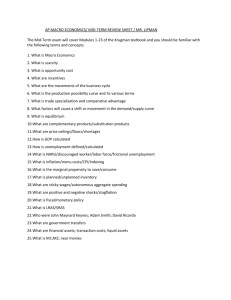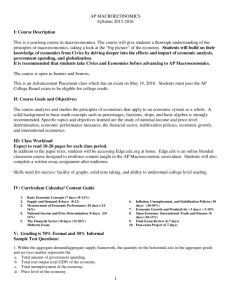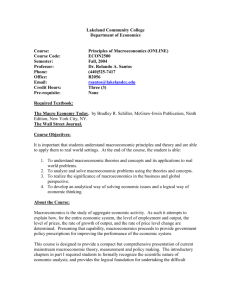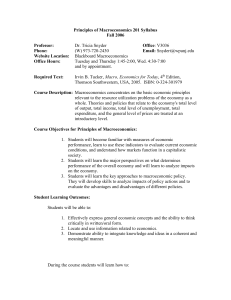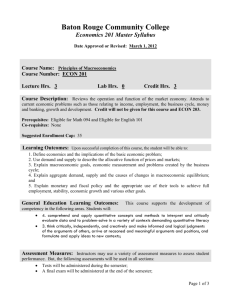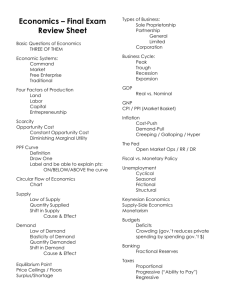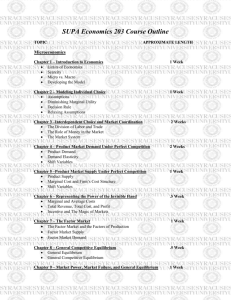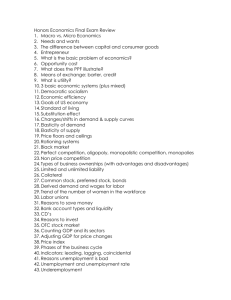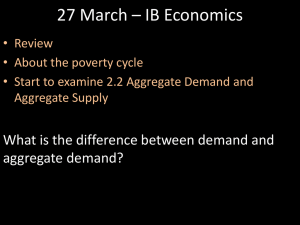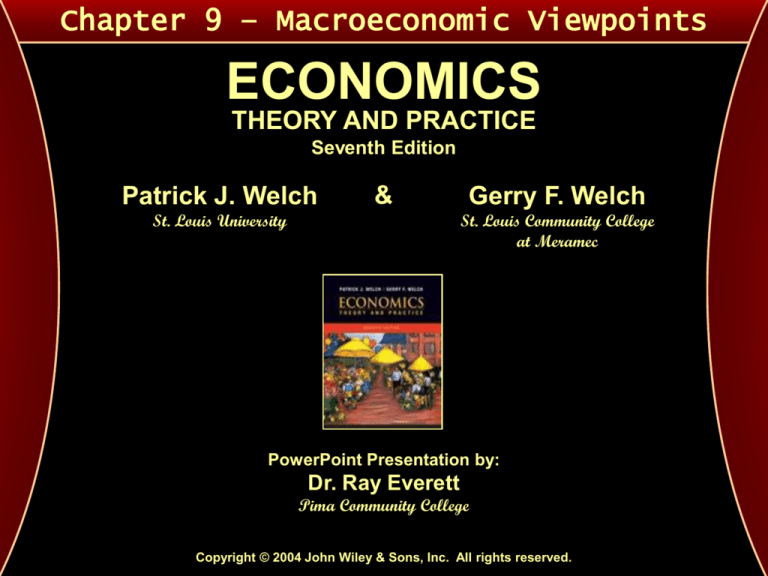
Chapter 9 – Macroeconomic Viewpoints
ECONOMICS
THEORY AND PRACTICE
Seventh Edition
Patrick J. Welch
&
St. Louis University
Gerry F. Welch
St. Louis Community College
at Meramec
PowerPoint Presentation by:
Dr. Ray Everett
Pima Community College
Copyright © 2004 John Wiley & Sons, Inc. All rights reserved.
Macroeconomic Viewpoints & Models
Contents
Macroeconomic Model Building
Viewpoints & Models
Inflation & Unemployment
Macroeconomic Viewpoints Summary
Macroeconomic Viewpoints & Models
Chapter Objectives
• To understand that there are several major macroeconomic models
with different assumptions that focus on different relationships.
• To recognize the historical dimension of macroeconomic theory.
• To discuss the fundamental relationships of the classical, new
classical, Keynesian, new Keynesian, and monetarist schools of
through.
• To describe the classical aggregate demand-aggregate supply model
and its conclusions.
• To understand the basic relationships in the Keynesian model, the
concept of macroequilibrium and the factors that influence it, and the
policy implication of the model.
• To explain the aggregate demand curve, the difference between shortrun and long-run aggregate supply, and the policy implications of the
new classical model.
• To identify the basic focus of new Keynesian economics and of
monetarism.
• To introduce the Phillips curve, examine U.S. rates of inflation and
unemployment, and identify reasons for shifts in the Phillips curve.
Macroeconomic Model Building
• Model Building Overview
Much of the work of economists is model building.
Models help to explain the relationship between
economic variables and help to answer why economic
problems or conditions occur.
Model building consists of:
•
•
•
•
Identifying variables
Establishing assumptions
Collecting and analyzing data
Interpreting conclusions
9-1
Viewpoints & Models
• Classical Economics
Popularly accepted theory prior to the Great Depression
of the 1930s.
Says the economy will automatically adjust to full
employment.
• Classical economists assume that:
– Supply creates its own demand in a macroeconomy.
– Wages and prices are flexible and increase or decrease to
ensure that the economy operates at full employment.
– Savings always equals investment, because changes in
the interest rate bring savings and investment into
equality.
9-2a
Viewpoints & Models
• Classical Economics (cont.)
FIGURE 9-1
Aggregate Supply and Aggregate Demand in Classical Economics
9-2b
Viewpoints & Models
• Keynesian Economics
Based on the work of John Maynard Keynes, who
focused on the role of aggregate spending in determining
the level of macroeconomic activity.
Introduced the idea that a macroeconomy seeks an
equilibrium output level.
• Macroeconomic Equilibrium
– Occurs when the amount of total planned spending on
new goods and services equals total output in the
economy.
If aggregate spending is greater than current production,
then output, employment, and income will all increase,
assuming that full employment has not been reached,
and vice versa.
• Inventories
– Stocks of goods on hand.
– Allows for spending to exceed current production.
9-2c
Viewpoints & Models
• Keynesian Economics (cont.)
TABLE 9-1
Total Output and Total Planned Spending (Trillions of Dollars)
9-2d
Viewpoints & Models
• Keynesian Economics (cont.)
FIGURE 9-2
Equilibrium in the Macroeconomy
9-2e
Viewpoints & Models
• Keynesian Economics (cont.)
Keynes pioneered the idea of using government
expenditures and taxes to control the level of economic
activity.
• He believed that a recession could be counteracted by
increasing aggregate spending through:
– Increasing government expenditures on goods and
services
– Increasing transfer payments
– Lowering taxes
9-2f
Viewpoints & Models
• Keynesian Economics (cont.)
FIGURE 9-3
Changes in Macroeconomic Equilibrium
9-2g
Viewpoints & Models
• New Classical Economics
Return to the basic classical premise that free markets
automatically stabilize themselves and that government
intervention in the macroeconomy is not advisable.
Brought about by what some argued to be holes in
Keynesian economics principles, which could not explain
or remedy some problems of the 1970s.
• Stagflation
– Occurs when an economy experiences high rates of both
inflation and unemployment.
More sophisticated explanations of aggregate demand
and aggregate supply.
9-2h
Viewpoints & Models
• New Classical Economics (cont.)
Downward-sloping aggregate demand curve was
explained through:
• Interest Rate Effect
– Interest rate moves with changes in overall prices.
– An inverse relationship exists between the interest rate
and the amount people borrow and spend.
• Wealth Effect
– In order to maintain the same amount of accumulated
wealth, people spend less when prices rise and more
when prices fall.
• Foreign Trade Effect
– A direct relationship exists between changes in overall
prices in an economy and spending on imports that
diverts spending from domestically produced output.
9-2i
Viewpoints & Models
• New Classical Economics (cont.)
FIGURE 9-4
Aggregate Demand in the New Classical Model
9-2j
Viewpoints & Models
• New Classical Economics (cont.)
Aggregate supply curve could be viewed in two ways:
• Short-run supply with three phases
– At low levels of output, the aggregate supply curve is
perfectly horizontal.
– As output increases beyond a certain point, a direct
relationship between prices and output is established.
– At high levels of output, the aggregate supply curve
becomes perfectly vertical.
• Long-run supply
– Perfectly vertical at the natural rate of unemployment, the
point to which the economy will move.
9-2k
Viewpoints & Models
• New Classical Economics (cont.)
FIGURE 9-5
Aggregate Supply in the New Classical Model
9-2l
Viewpoints & Models
• New Classical Economics (cont.)
Long Run Policy Implications
• Natural Rate Hypothesis
– Over the long run, unemployment will tend toward its
natural rate, and policies to reduce unemployment below
that level will be ineffective.
• Adaptive Expectations
– Households and businesses base their expectations of
the future on past and current experiences.
• Rational Expectations
– Households and businesses base their expectations of
future policies on how they think they will be affected by
these policies.
9-2m
Viewpoints
& Models
• New Keynesian Economics
Builds on the Keynesian view that the economy does not
automatically return to full employment.
Regards prices and wages as inflexible (or “sticky”)
downward rather than flexible as other schools believe.
• Monetarism
School of thought that favors stabilizing the economy
through controlling the money supply.
• Supply-Side Economics
Policies to achieve macroeconomic goals by stimulating
the supply side of the market.
Became popular in the 1980s.
9-2n
Inflation & Unemployment
• Phillips Curve
Curve showing the relationship between an economy’s
unemployment and inflation rates.
FIGURE 9-6
A Phillips Curve (Hypothetical Data)
9-3a
Inflation & Unemployment
• Phillips Curve (cont.)
Three factors may help to explain shifts in the Phillips
curve:
• Structural changes in the labor force
– 1970s: Increase in the labor force participation rates of
women and teenagers who, at the time, had higher
unemployment rates than men.
– 1980s & 1990s: Rate of unemployment for women fell, the
movement of teenagers into the market reversed itself,
and an increase in the rate of involuntary part-time
employment.
• Cost-push inflation
– 1970s & 1980s: Brought about by energy price increases.
• Eligibility for government transfer payments
– Availability of transfer payments increases
unemployment, and vice versa.
9-3b
Inflation & Unemployment
• Phillips Curve (cont.)
FIGURE 9-7
Annual Rates of Unemployment and Inflation in the United States
for 1960–2000 and Representative Phillips Curves
9-3c
Macroeconomic Viewpoints Summary
• Viewpoints Summary
No theory is designed to explain all the complex
relationships among the players and institutions of a
macroeconomy.
The economy is not composed of a set of simple
relationships that can be easily manipulated to neatly
solve various problems as they arise.
Assessing economic theories would be easier if we lived
in closed economies.
• Closed Economies
– Economy where foreign influences have no effect on
output, employment, and prices.
• Open Economies
– Economy where foreign influences have an effect on
output, employment, and prices.
9-4
Chapter 9 – Macroeconomic Viewpoints
This is the end of Chapter 9.
To return to the contents menu of this
chapter, click on the menu graphic to the
right of this text.
To begin Chapter 10, click on the next
chapter icon to the right of this text.
Menu
Next
Chapter
ECONOMICS
THEORY AND PRACTICE
Seventh Edition
Copyright © 2004 John Wiley & Sons, Inc. All rights reserved. Reproduction or translation of this work
beyond that permitted in Section 117 of the 1976 United States Copyright Act without the expressed
written permission of the copyright owner is unlawful. Request for further information should be
addressed to the Permissions Department, John Wiley & Sons, Inc. The purchaser may make back-up
copies for his/her own use only and not for distribution or resale. The Publisher assumes no
responsibility for errors, omissions, or damages, caused by the use of these programs or from the use
of the information contained herein.

